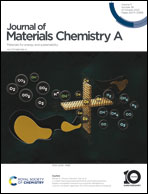The synergistic chemical coupling of nanostructured MoS2 with nitrogen-deficient 2-D triazine-based polymeric m-C3Nx for efficient and selective CO2 photocatalytic conversion to CO†
Abstract
Donor–acceptor-type heterostructured photocatalysts have been synthesized by coupling triazine-based mesoporous polymeric C3Nx with varied loading concentrations of MoS2, via a template-directed thermal decomposition synthesis followed by hydrothermal reaction, to further improve CO2 reduction efficacy and tune the selectivity. The appearance of two peaks at 12.7° (100) and 27.8° (002) confirms the formation of a tris-s-triazine polymeric framework, where, upon modification with MoS2, a slight shift was observed in the latter peak to a lower 2θ value, which implies a shorter interlayer stacking distance. The appearance of the XPS peak at 287.1 eV for the formation of C–S and the increased peak intensity at 235.5 eV corresponding to Mo6+ in the case of nitrogen-deficient MS–m-C3Nx-3 compared to that of the MS–m-CN-3 suggest a chemical coupling between the MoS2 and CN/C3Nx. The optimized MS–m-C3Nx-3 exhibits a higher CO formation rate (2095.05 μmol g−1) and faradaic efficiency of ∼31%, which is nearly 3-fold higher than those of MS–m-CN (579.29 μmol g−1 and 11%). The formation of CO was further confirmed by 13C NMR and GC-MS analysis, which shows the production of 12CO with an m/z value of 28. PEC measurements reveal more positive onset potential in the case of MS–m-C3Nx-3 than in MS–m-CN-3. Furthermore, the bare m-CN and m-C3Nx exhibit two notable CO2 desorption peaks; however, upon modification with MoS2 nanocrystals, MS–m-C3Nx-3 shows a single intense desorption peak at a higher temperature, revealing a single type of active site, suggesting selectivity for single-product formation, whereas MS–m-CN-3 exhibits a slight rise at the beginning of the peak, revealing the presence of more than one active site and corroborating the DFT calculations. The enhanced CO2 conversion efficiency of MS–m-C3Nx-3 compared to MS–m-CN-3 is due to the combination of an efficient charge separation and transfer kinetics, as revealed by the decrease in the average lifetime of photogenerated electrons (1.91 ns), lower charge transfer resistance, increased electron density upon illumination, and broadening of the VB (0.28 eV) in the case of MS–m-C3Nx-3 (as opposed to 0.05 eV in MS–m-CN-3).

- This article is part of the themed collection: #MyFirstJMCA


 Please wait while we load your content...
Please wait while we load your content...